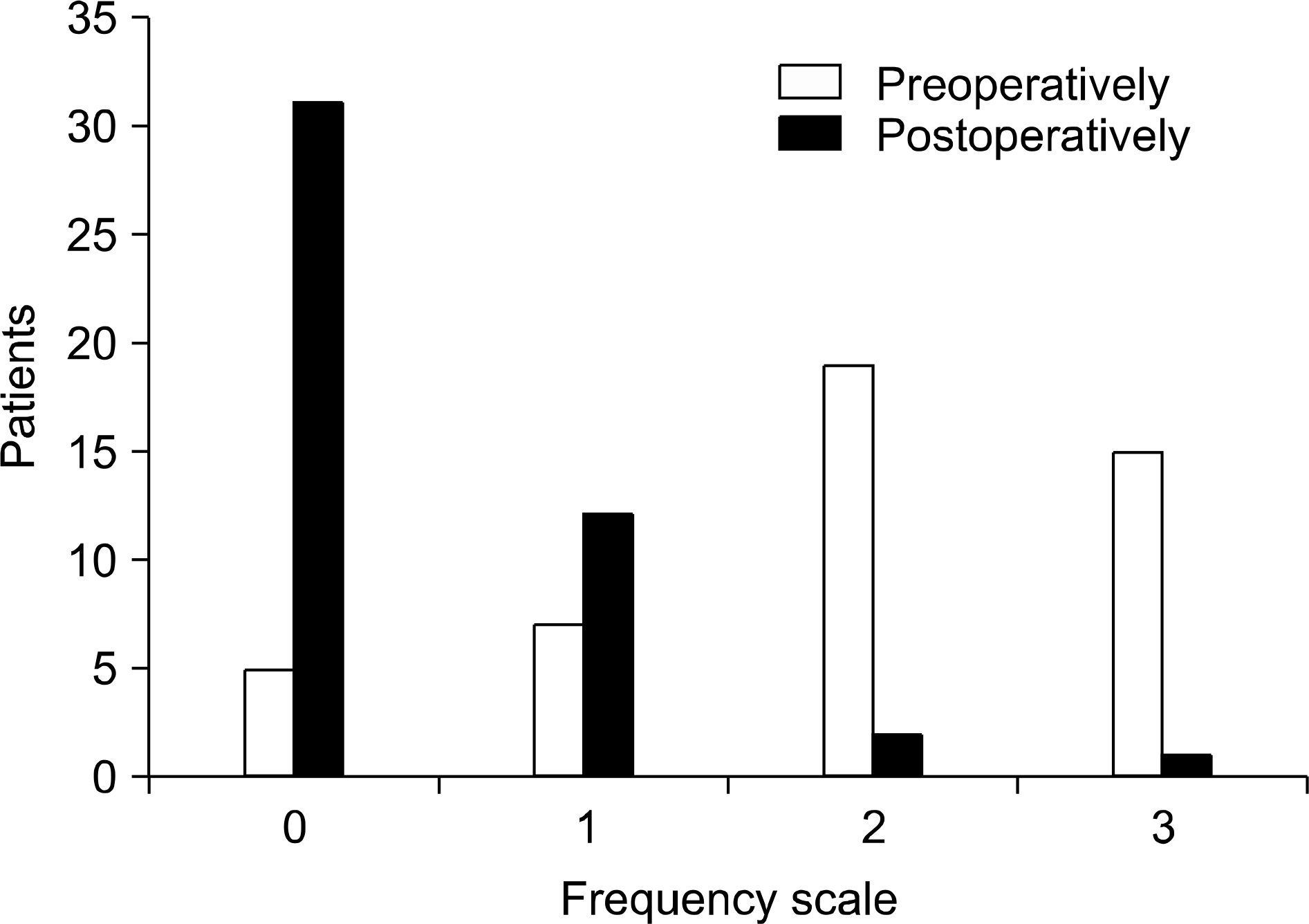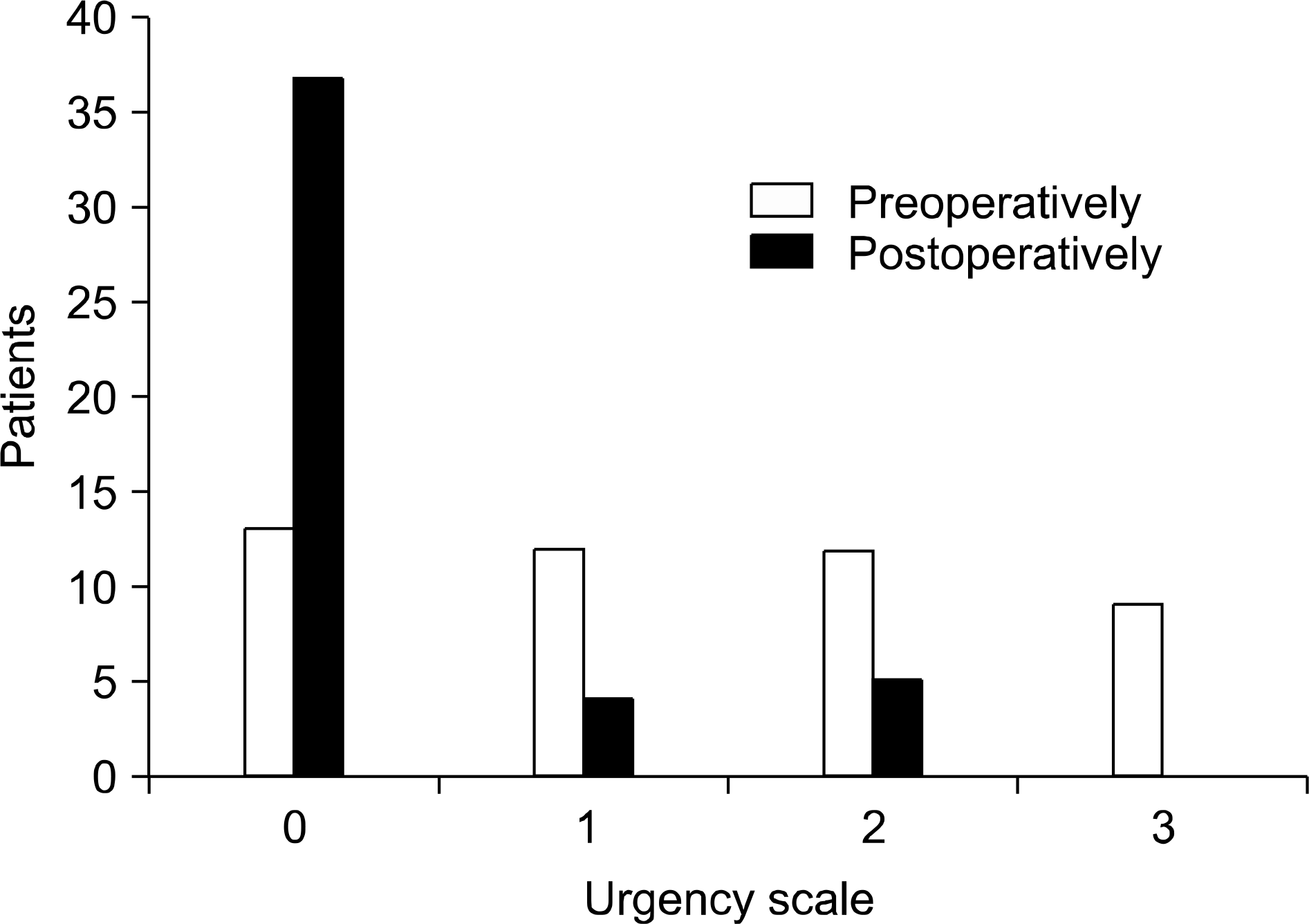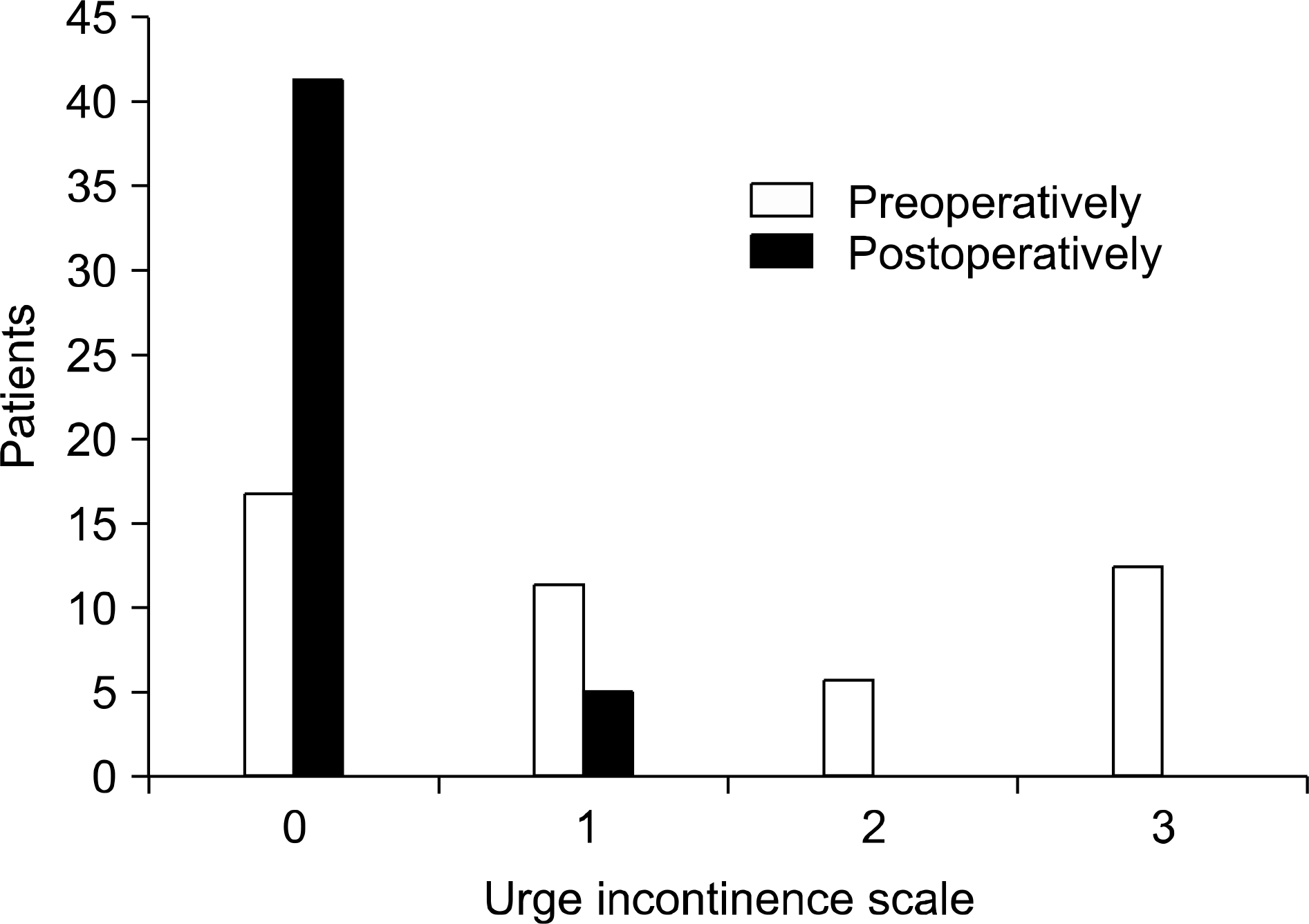Abstract
Purpose
A lot of patients with stress urinary incontinence (SUI) have lower urinary tract symptoms. So we evaluated the changes of voiding pattern following transobturator tape (TOT) operation, and investigated the factors for predicting persistent urinary frequency after operation.
Materials and Methods
The items of preoperative evaluations consisted of history taking, physical examination, cystometrography, 3 day frequency-volume chart and symptoms questionnaire. Patients with anticholinergics or any neurologic diseases that affect the voiding pattern were excluded. Between January to November 2006, 46 patients with TOT operation were enrolled, and were reevaluated with physical examination, 3 day frequency-volume chart and symptom questionnaires, postoperatively.
Results
The patients who voided 8 or more times per day had shorter symptom duration and higher body mass index (BMI) than those who voided under 8 times per day (each p<0.05). In 30 patients who void 8 or moretimes per day preoperatively, 17 (56.7%) patients became void under 8 times, postoperatively. In each patient who had urgency or urge incontinence symptoms preoperatively, respective 72.7 and 82.8% resolved their symptoms, postoperatively. No one complained de novo urgency or urge incontinence, postoperatively. In a multivariate analysis, the patient with a history of previous pelvic surgery or moderate to severe urge incontinence was tightly associated with an increased likelihood of persistent urinary frequency after TOT operation (odd ratio [OR] 24.8, 95% confidence interval [CI] 2.044-301.284, p=0.012 and OR 31.9, 95% CI 1.662-613.619, p=0.022, respectively).
Conclusions
The TOT operation can improve the symptoms of urinary frequency, urgency and urge incontinence in patients with SUI. However, the patients who had previous pelvic surgeriesor moderate to severe urge incontinence should be fully advised for the risk of sustaining frequency, postoperatively.
Go to : 
REFERENCES
1.Delorme E., Droupy S., de Tayrac R., Delmas V. Transobturator tape (Uratape): a new minimally-invasive procedure to treat female urinary incontinence. Eur Urol. 2004. 45:203–7.

2.Lee BG., Kim HS., Koh JS., Kim HW., Lee YS., Suh HJ, et al. The changes of storage symptoms after tension-free vaginal tape procedures in stress urinary incontinence patients. Korean J Urol. 2007. 48:1289–95.

4.Sung VW., Schleinitz MD., Rardin CR., Ward RM., Myers DL. Comparison of retropubic vs transobturator approach to midurethral slings: a systematic review and meta-analysis. Am J Obstet Gynecol. 2007. 197:3–11.

5.Roumeguere T., Quackels T., Bollens R., de Groote A., Zlotta A., Bossche MV, et al. Trans-obturator vaginal tape (TOT) for female stress incontinence: one year follow-up in 120 patients. Eur Urol. 2005. 48:805–9.

6.Elinoff V., Bavendam T., Glasser DB., Carlsson M., Eyland N., Roberts R. Symptom-specific efficacy of tolterodine extended release in patients with overactive bladder: the IMPACT trial. Int J Clin Pract. 2006. 60:745–51.

7.Starkman JS., Dmochowski RR. Urgency assessment in the evaluation of overactive bladder (OAB). Neurourol Urodyn. 2008. 27:13–21.

8.Teleman PM., Lidfeldt J., Nerbrand C., Samsioe G., Mattiasson A. Overactive bladder: prevalence, risk factors and relation to stress incontinence in middle-aged women. BJOG. 2004. 111:600–4.

9.Hung MJ., Ho ES., Shen PS., Sun MJ., Lin AT., Chen GD. Urgency is the core symptom of female overactive bladder syndrome, as demonstrated by a statistical analysis. J Urol. 2006. 176:636–40.

10.Choe JH., Choo MS., Lee KS. The impact of tension-free vaginal tape on overactive bladder symptoms in women with stress urinary incontinence: significance of detrusor overactivity. J Urol. 2008. 179:214–9.

11.Ku JH., Shin JW., Son H., Oh SJ., Kim SW., Paick JS. Predictive factors for persistent urgency or urge incontinence after tension-free vaginal tape procedure in mixed urinary incontinence. Korean J Urol. 2004. 45:330–6.
Go to : 
Table 1.
Comparison of clinical characteristics and parameters in relation to urinary frequency
| Urinary frequency <8 (%) | Urinary frequency ≥8 (%) | p-value | |
|---|---|---|---|
| No. of patients | 16 | 30 | |
| Median age at | 49.1 | 50.1 | |
| operation (range) | (42.0-63.2) | (30.8-73.5) | 0.782* |
| Symptom duration | 8.4±6.0 | 4.6±4.0 | 0.018* |
| SUI symptom grade | 0.726‡ | ||
| I | 6 (37.58) | 14 (46.7) | |
| II | 9 (56.3) | 14 (46.7) | |
| III | 1 (6.3) | 2 (6.7) | |
| Pad apply | 9 (56.3) | 17 (56.7) | 0.978† |
| Parity | 2.3±0.9 | 2.6±1.2 | 0.200* |
| Previous pelvic surgery | 3 (18.8) | 7 (23.3) | 0.859‡ |
| Postmenopause | 5 (31.3) | 13 (43.3) | 0.424† |
| BMI | 23.7±2.5 | 25.6±2.9 | 0.042* |
| Maximum voided volume | 388.8±145.0 | 347.7±83.2 | 0.031* |
| Q-tip test≥30o | 10 (62.5) | 17 (56.7) | 0.702† |
| VLPP<60cmH2O | 3 (18.8) | 9 (30.0) | 0.498‡ |
| Detrusor overactivity | 1 (6.3) | 9 (30.0) | 0.130‡ |
| Frequency scale | <0.001‡ | ||
| 0 | 5 (31.3) | 0 (0) | |
| 1 | 6 (37.5) | 1 (3.3) | |
| 2 | 4 (25.0) | 15 (50.0) | |
| 3 | 1 (6.3) | 14 (46.7) | |
| Urgency scale | 0.001‡ | ||
| 0 | 10 (62.5) | 3 (10.0) | |
| 1 | 3 (18.8) | 9 (30.0) | |
| 2 | 3 (18.8) | 9 (30.0) | |
| 3 | 0 (0) | 9 (30.0) | |
| Urge incontinence scale | 0.003‡ | ||
| 0 | 11 (68.8) | 6 (20.0) | |
| 1 | 4 (25.0) | 7 (23.3) | |
| 2 | 0 (0) | 6 (20.0) | |
| 3 | 1 (6.3) | 11 (36.7) | |
| Objective success rate | 0.789‡ | ||
| Cured | 15 (93.8) | 25 (83.3) | |
| Improved | 1 (6.3) | 2 (6.7) | |
| Failed | 0 (0) | 3 (6.5) |
Table 2.
Comparison of preoperative and postoperative parameters in patients who voided under 8 times per day
| Preoperatively | Postoperatively | p-value* | |
|---|---|---|---|
| No. of 24-hour frequency | 6.25±0.93 | 6.44±1.46 | 0.971 |
| No. of nocturia | 0.44±0.73 | 0.81±0.83 | 0.132 |
| Maximum voided volume | 396.88±117.63 | 388.75±145.05 | 0.874 |
| Frequency scale | 0.002 | ||
| 0 | 5 (31.3) | 14 (87.5) | |
| 1 | 6 (37.5) | 2 (12.5) | |
| 2 | 4 (25.0) | 0 (0.0) | |
| 3 | 1 (6.3) | 0 (0.0) | |
| Urgency scale | 0.038 | ||
| 0 | 10 (62.5) | 15 (93.8) | |
| 1 | 3 (18.8) | 1 (6.3) | |
| 2 | 3 (18.8) | 0 (0.0) | |
| 3 | 0 (0.0) | 0 (0.0) | |
| Urge incontinence scale | 0.034 | ||
| 0 | 11 (68.8) | 16 (100.0) | |
| 1 | 4 (25.0) | 0 (0.0) | |
| 2 | 0 (0) | 0 (0.0) | |
| 3 | 1 (6.3) | 0 (0.0) | |
Table 3.
Comparison of preoperative and postoperative parameters in patients who voided 8 or more times per day
| Preoperatively | Postoperatively | p-value* | |
|---|---|---|---|
| No. of 24-hour frequency | 10.20±2.19 | 7.80±2.34 | <0.001 |
| No. of nocturia | 1.30±0.99 | 0.83±0.70 | 0.008 |
| Maximum voided volume | 301.70±104.79 | 347.67±83.24 | 0.005 |
| Frequency scale | <0.001 | ||
| 0 | 0 (0) | 17 (56.7) | |
| 1 | 1 (3.3) | 10 (33.3) | |
| 2 | 15 (50.0) | 2 (6.7) | |
| 3 | 14 (46.7) | 1 (3.3) | |
| Urgency scale | <0.001 | ||
| 0 | 3 (10.0) | 22 (73.3) | |
| 1 | 9 (30.0) | 3 (10.0) | |
| 2 | 9 (30.0) | 5 (16.7) | |
| 3 | 9 (30.0) | 0 (0.0) | |
| Urge incontinence scale | <0.001 | ||
| 0 | 6 (20.0) | 25 (83.30) | |
| 1 | 7 (23.3) | 5 (16.7) | |
| 2 | 6 (20.0) | 0 (0.0) | |
| 3 | 11 (36.7) | 0 (0.0) | |
Table 4.
Univariate and multivariate predictors for persistent frequency after TOT




 PDF
PDF ePub
ePub Citation
Citation Print
Print





 XML Download
XML Download